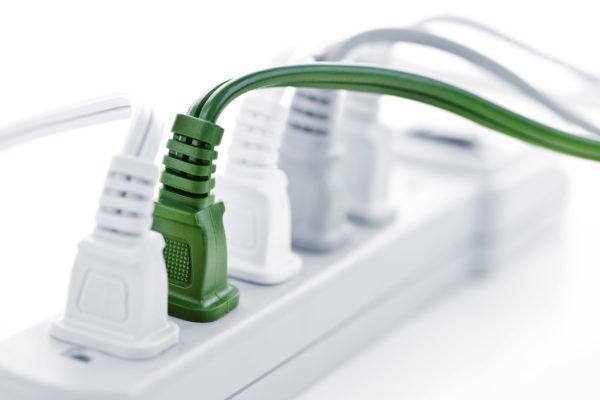Many homeowners are unaware of the dangers of electrical surges. An electrical surge is a sudden, uncontrolled increase in voltage that can damage home appliances and other electronic equipment. One of the most common problems caused by electrical surges is blown circuitry when too much electricity flows through the circuits, causing them to overheat and break. In some cases, when the circuits and breakers are old or overused, a surge can lead to a fire. Surges can be caused by lightning strikes, power outages, faulty wiring, or even downed power lines.
Without the right protection, electrical surges can be extremely dangerous. Like most people, you probably don’t give much thought to the surge protectors you use in your home. But if a storm knocks out your power or a faulty appliance damages your electronics, you’ll be glad you took the time to choose the right protector.
What Is a Surge Protector?
A surge protector is a device that helps regulate the flow of electricity to home electronics by absorbing surges in electrical current, which can damage sensitive electronic components. They can be used to protect everything from home entertainment systems to computers and home appliances.
How Do You Know If You Need a Surge Protector?
Homeowners often wonder if they actually need a surge protector for their home. Surge protectors can be a valuable addition to your home if you live in an area prone to thunderstorms, severe weather, or power outages. Another sign is if you experience frequent light flickering when your neighbors turn on their high-powered appliances.
Even if you do not experience these frequent electrical issues, you should still consider installing surge protectors to protect your expensive electronics and appliances, such as computers, home theater systems, refrigerators, and even your HVAC system.
Types of Surge Protectors
There are three main types of surge protectors: home surge protection, point-of-use surge protection, and portable surge protection. Home surge protection is installed at your electrical panel and protects your entire home. In contrast, point-of-use surge protection is installed at specific outlets and safeguards specific plugged-in devices. Portable surge protectors are small, lightweight devices that can be plugged into any outlet to protect your devices. You can often find higher-end electrical strips that come with surge protection built-in.
Not All Surge Protectors Are the Same
While all surge protectors do the job of protecting home electronics from power surges, they are not all the same. The most important factor to consider when choosing a surge protector is the Joule rating, which is a measurement of how much energy the surge protector can safely take in and protect the plugged-in equipment. Higher joule ratings mean the surge protector can take in more surge current before it fails.
Another factor to consider is the clamping voltage, which is the maximum surge voltage that the protector will allow through to your devices. While the common protectors offer a clamping voltage of 330V, 400V, and 500V, the lower options are better at protecting your devices.
You will also want to ensure that the surge protector you choose has a response time of less than one nanosecond, which is the amount of time it takes for the surge protector to start redirecting the surge current away from your devices. For protectors that have a response time of more than one nanosecond, there is a chance that some surge current will reach your devices before the surge protector can react.
Lastly, not all surge protectors offer the same warranty policies. Some surge protector companies will replace your surge protector if it is damaged by a power surge, while others will only provide a partial refund or no replacement. Be sure to read the fine print before purchasing to see what kind of warranty is offered.
What Factors Should You Consider When Choosing a Surge Protector?
When choosing a surge protector, you should consider the number of devices that you need to protect, the type of surge protection that you need, the warranty policy, and your budget.
If you need to protect multiple devices, you may want to choose a home surge protector. A point-of-use surge protector may be sufficient if you only need to protect a few devices. Portable surge protectors are a good option if you need protection for devices that are not always plugged in, such as laptops and TVs.
Depending on your needs, you may require a stronger protector with low clamping voltage and minimal response time for your expensive high-power devices such as your heating and cooling unit, home entertainment system, and computers. A lower-grade protector can easily suffice for less power-demanding devices, such as your microwave and internet devices.
Although the warranty policy may not be as important as portable surge protectors, it can decide if you are thinking about a home surge protector or a point-of-use surge protector. Because these systems are much more expensive, you will want to be sure that the surge protector you choose offers a replacement policy in case of damage.
Finally, consider your budget when choosing a surge protector. Portable surge protectors are typically the most affordable option, while home surge protectors tend to be the most expensive. Many different surge protector manufacturers and models are available on the market today, so be sure to compare prices and features before making your purchase.
Why Should You Choose Home Surge Protectors?
Even though home surge protector installations require more money and time upfront, they offer many benefits that make them worth the investment. Home surge protectors are generally of better quality because manufacturers typically test home surge protectors to a higher standard than portable or point-of-use surge protectors.
Home surge protectors offer protection against both external and internal power surges. External power surges can come from lightning strikes or power outages, while internal power surges can be caused by faulty wiring or appliances. And being connected to your home’s electrical panel, the system will protect all of the devices in your home even if they are not plugged into the surge protector.
If you live in an area with drastic temperature changes, your heating and cooling system can be a life-or-death necessity. A home surge protector will help protect your HVAC system from power surges, keeping you and your family safe and comfortable all year round.
Getting a Professional Home Surge Protector
While the average person can install portable and point-of-use surge protectors, home surge protectors require knowledge of your home’s electrical system. If you live in the Triangle Community and surrounding areas, let Thermo Direct guide you through the process. Our professional surge protection installers assess your home’s electrical needs and recommend the best surge protector for your home. They will also be able to install the surge protector in the most effective way possible, ensuring that your home and belongings are safe from power surges.
Thermo Direct of Raleigh, NC, also offers heating and cooling maintenance, repair, and installation services to meet your home comfort needs. Along with surge protectors, we also provide a wide range of electrical services, including lighting and ceiling fan installation, generator repair and installation, duct installation, repair, and sealing, and circuit breaker service. Whatever you need, don’t hesitate to call us today to schedule a free consultation.









